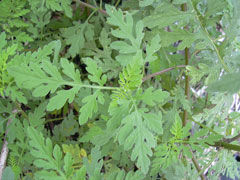 |
|
http://www.hear.org/starr/ |
 |
| http://www.hear.org/starr/ |
Translate this page:
Summary
Bloom Color: Green.
Main Bloom Time: Early fall, Late summer, Mid summer, Mid fall. Form: Upright or erect. Other Names : Annual Ragweed, Bitterweed, Blackweed, Carrot Weed, Hay Fever Weed, Roman Wormwood, Stammerwort, Stickweed, Tassel Weed, Wild Tansy, and American Wormwood.
Physical Characteristics

 Ambrosia artemesiifolia is a ANNUAL growing to 0.9 m (3ft) by 0.2 m (0ft 8in) at a medium rate.
Ambrosia artemesiifolia is a ANNUAL growing to 0.9 m (3ft) by 0.2 m (0ft 8in) at a medium rate.
See above for USDA hardiness. It is hardy to UK zone 4. It is in flower from August to October. The species is monoecious (individual flowers are either male or female, but both sexes can be found on the same plant) and is pollinated by Wind.
Suitable for: light (sandy), medium (loamy) and heavy (clay) soils. Suitable pH: mildly acid, neutral and basic (mildly alkaline) soils. It can grow in semi-shade (light woodland) or no shade. It prefers moist soil.
UK Hardiness Map
US Hardiness Map
Synonyms
A. elatior.
Plant Habitats
Woodland Garden Cultivated Beds;
Edible Uses
Edible Parts: Oil
Edible Uses: Oil
An oil is obtained from the seed. It has been suggested for edible purposes because it contains little linolenic acid[61, 183]. The seed contains up to 19% oil[61], it has slightly better drying properties than soya bean oil[183].
References More on Edible Uses
Medicinal Uses
Plants For A Future can not take any responsibility for any adverse effects from the use of plants. Always seek advice from a professional before using a plant medicinally.
Antidote Astringent Disinfectant Emetic Febrifuge Women's complaints
The leaves are very astringent, emetic and febrifuge[222, 257]. They are applied externally to insect bites, rheumatic joints and various skin complaints, internally they are used as a tea in the treatment of fevers, pneumonia, nausea, intestinal cramps, diarrhoea and mucous discharges[222, 257]. Juice from the wilted leaves is disinfectant and is applied to infected toes[257]. A tea made from the roots is used in the treatment of menstrual disorders and stroke[222]. The pollen is harvested commercially and manufactured into pharmaceutical preparations for the treatment of allergies to the plant[222].
References More on Medicinal Uses
The Bookshop: Edible Plant Books
Our Latest books on Perennial Plants For Food Forests and Permaculture Gardens in paperback or digital formats.

Edible Tropical Plants
Food Forest Plants for Hotter Conditions: 250+ Plants For Tropical Food Forests & Permaculture Gardens.
More

Edible Temperate Plants
Plants for Your Food Forest: 500 Plants for Temperate Food Forests & Permaculture Gardens.
More

More Books
PFAF have eight books available in paperback and digital formats. Browse the shop for more information.
Shop Now
Other Uses
Disinfectant Oil
There is some indication it has been used as a disinfectant and Oil.
Special Uses
References More on Other Uses
Cultivation details
We have very little information on this species but suggest growing it in a sunny position in a well-drained soil. It has been suggested for commercial cultivation[61]. Some plants produce mainly sterile heads[60]. The pollen from the flowers of this species is an important cause of hay-fever in N. America[17]. Special Features:North American native, Invasive, Inconspicuous flowers or blooms.
References Carbon Farming Information and Carbon Sequestration Information
Temperature Converter
Type a value in the Celsius field to convert the value to Fahrenheit:
Fahrenheit:
The PFAF Bookshop
Plants For A Future have a number of books available in paperback and digital form. Book titles include Edible Plants, Edible Perennials, Edible Trees,Edible Shrubs, Woodland Gardening, and Temperate Food Forest Plants. Our new book is Food Forest Plants For Hotter Conditions (Tropical and Sub-Tropical).
Shop Now
Plant Propagation
Seed - we have no details for this species but suggest sowing the seed in situ in April.
Other Names
If available other names are mentioned here
Native Range
Coming Soon
Weed Potential
Right plant wrong place. We are currently updating this section.
Please note that a plant may be invasive in one area but may not in your area so it's worth checking.
It is listed as a noxious weed in Illinois (common ragweed) and Oregon
(ragweed)as a "B" designated weed. Ragweed is a very competitive weed and can produce yield losses in soybeans as high as 30%. Control with night tillage reduces emergence by around 45%. Small grains in rotation will also suppress common ragweed if they are overseeded with clover. Otherwise, the ragweed will grow and mature and produce seed in the small grain stubble.
Conservation Status
IUCN Red List of Threatened Plants Status : This taxon has not yet been assessed.

Growth: S = slow M = medium F = fast. Soil: L = light (sandy) M = medium H = heavy (clay). pH: A = acid N = neutral B = basic (alkaline). Shade: F = full shade S = semi-shade N = no shade. Moisture: D = dry M = Moist We = wet Wa = water.
Now available:
Food Forest Plants for Mediterranean Conditions
350+ Perennial Plants For Mediterranean and Drier Food Forests and Permaculture Gardens.
[Paperback and eBook]
This is the third in Plants For A Future's series of plant guides for food forests tailored to
specific climate zones. Following volumes on temperate and tropical ecosystems, this book focuses
on species suited to Mediterranean conditions—regions with hot, dry summers and cool, wet winters,
often facing the added challenge of climate change.
Read More
Expert comment
Author
L.
Botanical References
60235
Links / References
For a list of references used on this page please go here
Readers comment